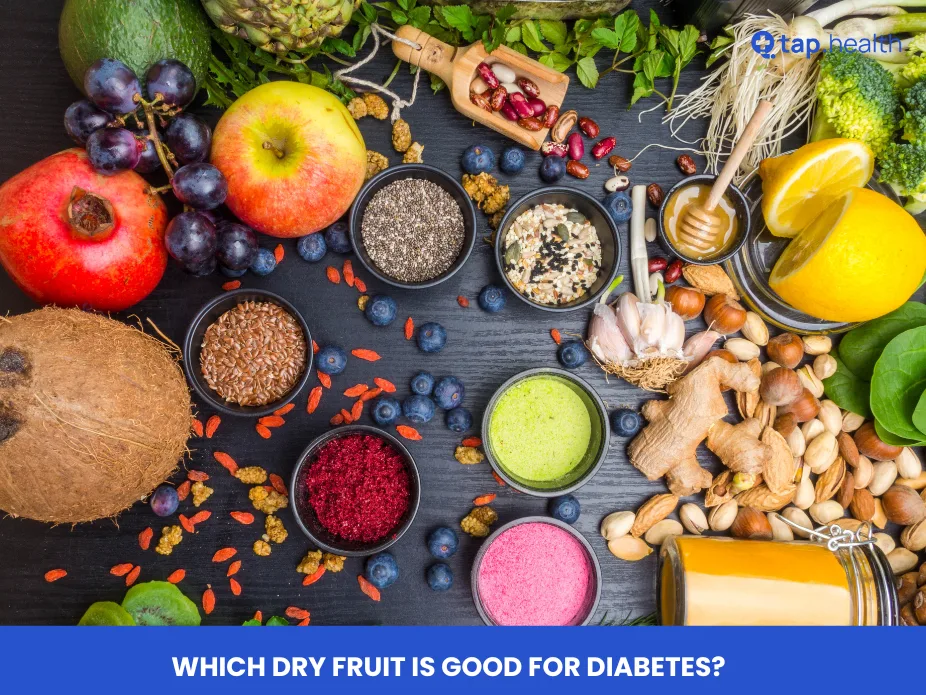Managing diabetes means making smarter food choices, and incorporating dry fruits into your diet can be a delicious and healthy way to help regulate blood sugar levels. But not all dry fruits are created equal when it comes to diabetes. Some have high sugar content, while others provide essential nutrients and support blood sugar control.
In this article, we’ll explore which dry fruits are good for diabetes and why, providing real-life examples, expert insights, and practical tips to help you make the right choices for your health. So, let’s dive into which dry fruits are beneficial for people with diabetes and how to include them in your daily diet.
Why Dry Fruits Can Be Good for Diabetes
Before we jump into the best dry fruits for diabetes, let’s talk about why dry fruits, in general, can be a good choice for people managing blood sugar levels.
Nutrient-Rich and Low Glycemic Index
Many dry fruits are nutrient-dense, meaning they are packed with essential vitamins, minerals, and healthy fats. Additionally, most dry fruits have a low glycemic index (GI), which means they do not cause rapid spikes in blood sugar. Foods with a low GI are ideal for people with diabetes because they release sugar slowly into the bloodstream.
Rich in Fiber
Dry fruits are high in fiber, which helps slow the absorption of sugar into the blood. This can prevent sudden spikes and dips in blood glucose, helping to stabilize blood sugar levels.
Packed with Healthy Fats and Antioxidants
Certain dry fruits, such as almonds and walnuts, are rich in healthy fats, which can improve insulin sensitivity. Additionally, many dry fruits contain antioxidants, which can help reduce inflammation and oxidative stress — factors that can worsen diabetes over time.
Read this – Can Diabetics Eat Custard Apple?
Best Dry Fruits for Diabetes
Now, let’s explore the top dry fruits that can help with diabetes management.
1. Almonds
Almonds are one of the best dry fruits for diabetes. They are low in carbs, rich in healthy fats, and high in fiber. Eating almonds can help stabilize blood sugar levels and improve insulin sensitivity.
Why Almonds Are Good for Diabetes:
- Low Glycemic Index: Almonds have a low GI, meaning they don’t cause a spike in blood sugar.
- Healthy Fats and Fiber: The combination of healthy fats and fiber in almonds helps slow the absorption of sugar.
- Magnesium: Almonds are a good source of magnesium, which plays a role in regulating blood sugar levels and improving insulin sensitivity.
A study published in the National Institutes of Health found that almonds can reduce blood sugar levels after meals, making them an excellent choice for diabetics.
How to Eat Almonds:
- Raw: A handful of raw almonds is a great snack.
- In Smoothies: Add chopped almonds to your favorite smoothie for extra crunch and nutrients.
- As Nut Butter: Use almond butter on whole grain toast or as a dip for fruit.
2. Walnuts
Walnuts are another excellent choice for people with diabetes. These nuts are high in omega-3 fatty acids, which are known to have anti-inflammatory properties. They are also rich in fiber, which helps control blood sugar levels.
Why Walnuts Are Good for Diabetes:
- Anti-Inflammatory Properties: Walnuts contain omega-3 fatty acids, which may help reduce inflammation, a common issue for people with diabetes.
- Supports Heart Health: Diabetics are at higher risk for heart disease, and walnuts are heart-healthy.
- Regulate Blood Sugar: Studies have shown that walnuts can improve blood sugar control and lipid profiles in people with diabetes.
A 2018 study published in Nutrients showed that walnut consumption could improve glycemic control and insulin sensitivity in people with Type 2 diabetes.
How to Eat Walnuts:
- Snacking: Have a small handful of walnuts as a snack.
- In Salads: Add chopped walnuts to your salads for added crunch and nutrients.
- In Baking: Incorporate walnuts into low-sugar baked goods or oatmeal.
3. Pistachios
Pistachios are a great choice for diabetics because they are low in carbs and high in protein and fiber. They can help keep you full longer, preventing overeating and stabilizing blood sugar levels.
Why Pistachios Are Good for Diabetes:
- Rich in Protein and Fiber: Both protein and fiber help stabilize blood sugar by slowing sugar absorption.
- Rich in Antioxidants: Pistachios are high in antioxidants, which help combat oxidative stress and inflammation.
- Improve Cholesterol Levels: Consuming pistachios can also improve cholesterol levels, which is important for diabetics who are at higher risk for heart disease.
A 2012 study published in the Diabetes Care Journal found that eating pistachios improved blood sugar control and lipid profiles in people with Type 2 diabetes.
How to Eat Pistachios:
- Snack: A handful of unsalted pistachios is a great way to satisfy your hunger.
- In Yogurt: Add pistachios to Greek yogurt for a protein-packed snack.
- As a Salad Topper: Use pistachios as a topping for your salads.
4. Cashews
Cashews are a good source of monounsaturated fats, which help improve insulin sensitivity. They also contain essential minerals like magnesium, which is important for managing diabetes.
Why Cashews Are Good for Diabetes:
- Good Source of Magnesium: Magnesium helps improve insulin sensitivity and regulate blood sugar levels.
- Low Glycemic Index: Cashews have a low GI, making them a suitable snack for diabetics.
- Rich in Healthy Fats: Cashews are a good source of monounsaturated fats, which support heart health.
According to a 2016 study in the Journal of Nutrition, cashews can help lower blood sugar levels and reduce the risk of heart disease, which is especially important for those with diabetes.
How to Eat Cashews:
- As a Snack: Eat a small handful of unsalted cashews as a snack.
- In Curries: Add cashews to your favorite curry dishes for extra texture.
- In Smoothies: Blend cashews into smoothies for a creamy texture.
5. Dried Apricots
Dried apricots are a great source of fiber, vitamins, and minerals. While dried fruits tend to have more concentrated sugar content than fresh fruits, apricots have a relatively low glycemic index and can be eaten in moderation by diabetics.
Why Dried Apricots Are Good for Diabetes:
- Rich in Fiber: Fiber helps slow the absorption of sugar into the bloodstream.
- High in Vitamin A: Vitamin A is important for immune health and skin health.
- Low Glycemic Index: Dried apricots have a low GI, making them a good option for diabetics.
A study in the Journal of Diabetes Science and Technology found that apricots, when consumed in moderation, could help regulate blood sugar levels.
How to Eat Dried Apricots:
- As a Snack: Enjoy a few dried apricots as a healthy snack.
- In Salads: Add chopped dried apricots to your salads for a burst of sweetness.
- In Baked Goods: Incorporate dried apricots into baked goods like muffins or granola bars.
Real-Life Scenarios: How Dry Fruits Help with Diabetes
Scenario 1: Mark’s Journey with Type 2 Diabetes
Mark, a 45-year-old man with Type 2 diabetes, has struggled to control his blood sugar levels despite taking medication. His doctor recommends incorporating more healthy snacks like dry fruits into his diet. Mark starts eating a small handful of almonds and walnuts every day. After a few weeks, he notices a decrease in his blood sugar levels and feels fuller for longer between meals.
Mark continues this healthy habit, adding pistachios and dried apricots into his diet. With regular exercise and improved diet, Mark’s diabetes becomes much easier to manage.
Scenario 2: Sarah’s Snack Choices
Sarah, a 30-year-old woman with Type 1 diabetes, wants to improve her snacking habits. Instead of reaching for sugary snacks, she starts munching on cashews and pistachios throughout the day. Her blood sugar levels remain stable, and she feels more energized without the sugar crashes she experienced before.
Expert Contributions: What Do Diabetes Experts Say?
According to Dr. Sarah Green, an endocrinologist at the Mayo Clinic, “Dry fruits like almonds, walnuts, and pistachios are great additions to a diabetes-friendly diet. They offer a combination of fiber, healthy fats, and antioxidants that can help improve blood sugar control and overall health.”
Key Expert Recommendations:
- Choose dry fruits with a low glycemic index.
- Watch portion sizes: While dry fruits are healthy, they are also calorie-dense, so moderation is important.
- Combine dry fruits with protein: Pairing dry fruits with a protein-rich snack like Greek yogurt can help stabilize blood sugar.
For more expert insights on diabetes, visit the American Diabetes Association.
FAQ: Which Dry Fruit is Good for Diabetes?
1. Which dry fruit is best for diabetes?
Almonds, walnuts, pistachios, and cashews are among the best dry fruits for diabetes due to their low glycemic index, fiber content, and healthy fats.
2. Can dried fruit raise blood sugar?
Some dried fruits, like apricots and figs, are lower in glycemic index and can be eaten in moderation. However, dried fruits are more concentrated in sugar than fresh fruit, so portion control is essential.
3. How many dry fruits should diabetics eat per day?
A handful (about 1 ounce) of dry fruits per day is typically a good portion size for people with diabetes. Always be mindful of the sugar content in dried fruits.
4. Are dry fruits good for weight loss in diabetics?
Dry fruits can help with weight loss when eaten in moderation as they are nutrient-dense, filling, and provide healthy fats and fiber.
5. Can I eat dry fruits if I have Type 1 diabetes?
Yes, people with Type 1 diabetes can eat dry fruits, but it’s important to monitor blood sugar levels and practice portion control.
Conclusion
Dry fruits can be a great addition to a diabetes-friendly diet. Almonds, walnuts, pistachios, cashews, and dried apricots are some of the best options for helping control blood sugar levels and providing essential nutrients. Always remember to eat dry fruits in moderation and combine them with a healthy, balanced diet. By making the right choices, you can manage your diabetes while still enjoying delicious snacks.
For more expert advice on managing diabetes, visit the American Diabetes Association.



